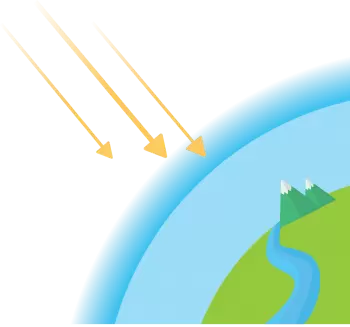
Solar radiation is an important meteorological variable that determines the amount of "heat" that we will receive from the sun on the earth's surface. Unfortunately, this amount of solar radiation is being altered by climate change and the retention of greenhouse gases.
Solar radiation is electromagnetic radiation capable of heating the surface of the ground and objects (including ours) without hardly heating the air.
Due to the characteristics of the Earth's atmosphere, solar radiation undergoes specific alterations to pass through it and reach the surface.
How much solar radiation is absorbed by the atmosphere?
The average intensity of solar energy reaching the top of the atmosphere facing the Sun is about 1,366 watts per square meter (solar constant). This amount of solar irradiance is related to the thresholds of the atmosphere and the plane perpendicular to the incoming solar rays.
The atmosphere, in turn, filters the Sun's rays to a certain extent, as does everybody, causing:
-
A reflection and a back-scattering of the rays, due to their albedo, to the clouds and atmospheric gases themselves.
-
An absorption that causes an increase in temperature due to emitting radiation in any direction according to Wien's law. However, this absorption is modest in the visible light band, making it transparent to direct solar radiation.
About half of the solar radiation that reaches passing through the atmosphere remains unaltered. The radiation that does this is called net radiation. Half of the net radiation ultimately contributes to the evaporation of water masses. Therefore the available solar energy is approximately a quarter of the total energy emitted.
Thanks to the ozone layer, the stratosphere absorbs ultraviolet rays included in the 200-300 nm band. The troposphere absorbs infrared radiation thanks to water vapor and CO2. The filtering action of the bands in the ultraviolet wavelengths, mostly lethal, is essential for the development of life.
What is the greenhouse effect?
The greenhouse effect is a natural and beneficial phenomenon for the Earth system.
Certain gases present in the atmosphere retain part of the thermal radiation emitted by the earth's surface after being heated by the sun plus the Earth radiation, keeping the planet's energy budget stable. The radiation budget is crucial to have the temperature at an adequate level for the development of life.
However, man’s action has increased these gases in the atmosphere —mainly carbon dioxide and methane—causing them to retain more outgoing radiation, increasing the planetary temperature. It is what we know as global warming.
What is diffuse solar radiation?
Diffuse radiation is also called indirect radiation. It depends on the atmospheric conditions.
Diffuse radiation represents the portion of solar radiation that has hit at least one particle of atmospheric gases by changing the angle of incidence. Nevertheless, it reaches the ground because it is directed towards it. That’s because in de polar regions.
Increases relative to total in cloudy skies. In particular, the Rayleigh scattering of the blue component of solar radiation is responsible for the blue color of the sky. Some of the diffuse radiation is back into space.
What is incident solar radiation?
Incident solar radiation is the amount of solar energy that has encountered any obstacle to which it has delivered all or part of its energy. The energy that does not reach the earth's surface is said to be extinct and is made up of radiation re-emitted, reflected, and backscattered into space.
According to Lambert's law, the amount of radiation that hits the unit area is proportional to the incidence angle cosine.
The maximum amount of incident solar irradiation is obtained with perpendicular incidence. Since the angle increases, both the surface is affected by the same amount of radiation and the thickness of the atmosphere crossed by these increases. Thus, it creates the daily, annual, and latitudinal variations in solar irradiance.
What is the reflected solar radiation?
Reflected solar radiation is the part of incident solar radiation reflected from the earth's surface due to the albedo effect.
The albedo is the reflection coefficient c. Values of c are generally between 0 and 1 or are expressed as a percentage. It is given by the relationship between the radiant energy reflected from a surface concerning the incident energy. The Earth has an average value of 40% (c = 0.4). At the albedo altitude of the Earth, we add the radiations reflected by atmospheric particles into space.
What is absorbed solar radiation?
After deducting all the losses due to reflection and backscattering from the atmosphere and the Earth's surface, the remaining incident solar radiation is absorbed by the Earth's surface. It thus variably contributes to its warming depending on the latitude and the type of surface.